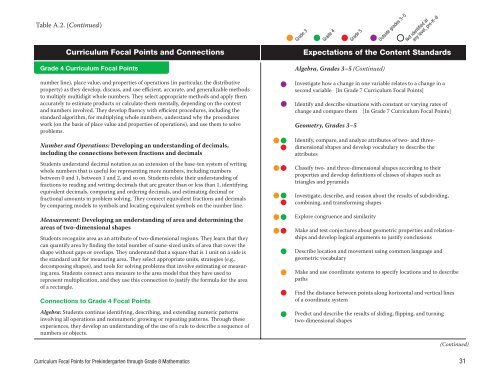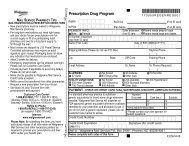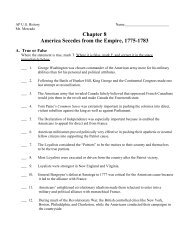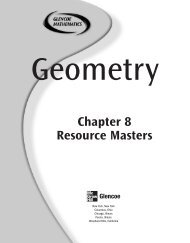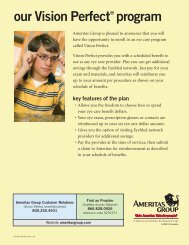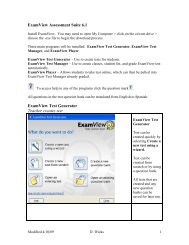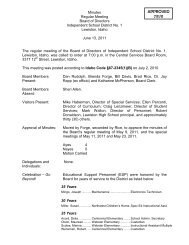Curriculum Focal Points
Curriculum Focal Points
Curriculum Focal Points
You also want an ePaper? Increase the reach of your titles
YUMPU automatically turns print PDFs into web optimized ePapers that Google loves.
Table A.2. (Continued)<br />
<strong>Curriculum</strong> <strong>Focal</strong> <strong>Points</strong> and Connections<br />
Grade 3<br />
Grade 4<br />
Grade 5<br />
Outside grades 3–5<br />
Not identified at<br />
any level, pre-K–8<br />
Expectations of the Content Standards<br />
Grade 4 <strong>Curriculum</strong> <strong>Focal</strong> <strong>Points</strong><br />
number line), place value, and properties of operations (in particular, the distributive<br />
property) as they develop, discuss, and use efficient, accurate, and generalizable methods<br />
to multiply multidigit whole numbers. They select appropriate methods and apply them<br />
accurately to estimate products or calculate them mentally, depending on the context<br />
and numbers involved. They develop fluency with efficient procedures, including the<br />
standard algorithm, for multiplying whole numbers, understand why the procedures<br />
work (on the basis of place value and properties of operations), and use them to solve<br />
problems.<br />
Number and Operations: Developing an understanding of decimals,<br />
including the connections between fractions and decimals<br />
Students understand decimal notation as an extension of the base-ten system of writing<br />
whole numbers that is useful for representing more numbers, including numbers<br />
between 0 and 1, between 1 and 2, and so on. Students relate their understanding of<br />
fractions to reading and writing decimals that are greater than or less than 1, identifying<br />
equivalent decimals, comparing and ordering decimals, and estimating decimal or<br />
fractional amounts in problem solving. They connect equivalent fractions and decimals<br />
by comparing models to symbols and locating equivalent symbols on the number line.<br />
Measurement: Developing an understanding of area and determining the<br />
areas of two-dimensional shapes<br />
Students recognize area as an attribute of two-dimensional regions. They learn that they<br />
can quantify area by finding the total number of same-sized units of area that cover the<br />
shape without gaps or overlaps. They understand that a square that is 1 unit on a side is<br />
the standard unit for measuring area. They select appropriate units, strategies (e.g.,<br />
decomposing shapes), and tools for solving problems that involve estimating or measuring<br />
area. Students connect area measure to the area model that they have used to<br />
represent multiplication, and they use this connection to justify the formula for the area<br />
of a rectangle.<br />
Connections to Grade 4 <strong>Focal</strong> <strong>Points</strong><br />
Algebra: Students continue identifying, describing, and extending numeric patterns<br />
involving all operations and nonnumeric growing or repeating patterns. Through these<br />
experiences, they develop an understanding of the use of a rule to describe a sequence of<br />
numbers or objects.<br />
Algebra, Grades 3–5 (Continued)<br />
Investigate how a change in one variable relates to a change in a<br />
second variable [In Grade 7 <strong>Curriculum</strong> <strong>Focal</strong> <strong>Points</strong>]<br />
Identify and describe situations with constant or varying rates of<br />
change and compare them [In Grade 7 <strong>Curriculum</strong> <strong>Focal</strong> <strong>Points</strong>]<br />
Geometry, Grades 3–5<br />
Identify, compare, and analyze attributes of two- and threedimensional<br />
shapes and develop vocabulary to describe the<br />
attributes<br />
Classify two- and three-dimensional shapes according to their<br />
properties and develop definitions of classes of shapes such as<br />
triangles and pyramids<br />
Investigate, describe, and reason about the results of subdividing,<br />
combining, and transforming shapes<br />
Explore congruence and similarity<br />
Make and test conjectures about geometric properties and relationships<br />
and develop logical arguments to justify conclusions<br />
Describe location and movement using common language and<br />
geometric vocabulary<br />
Make and use coordinate systems to specify locations and to describe<br />
paths<br />
Find the distance between points along horizontal and vertical lines<br />
of a coordinate system<br />
Predict and describe the results of sliding, flipping, and turning<br />
two-dimensional shapes<br />
(Continued)<br />
<strong>Curriculum</strong> <strong>Focal</strong> <strong>Points</strong> for Prekindergarten through Grade 8 Mathematics


